IWC’s Timezoner was developed to be an ideal travel companion. A quick spin of the bezel suffices to show a new time zone, and a built-in flyback chronograph makes this an exceptional timepiece at a reasonable price. We give it a closer look in this feature from the WatchTime archives, with original photography by Olaf Köster.
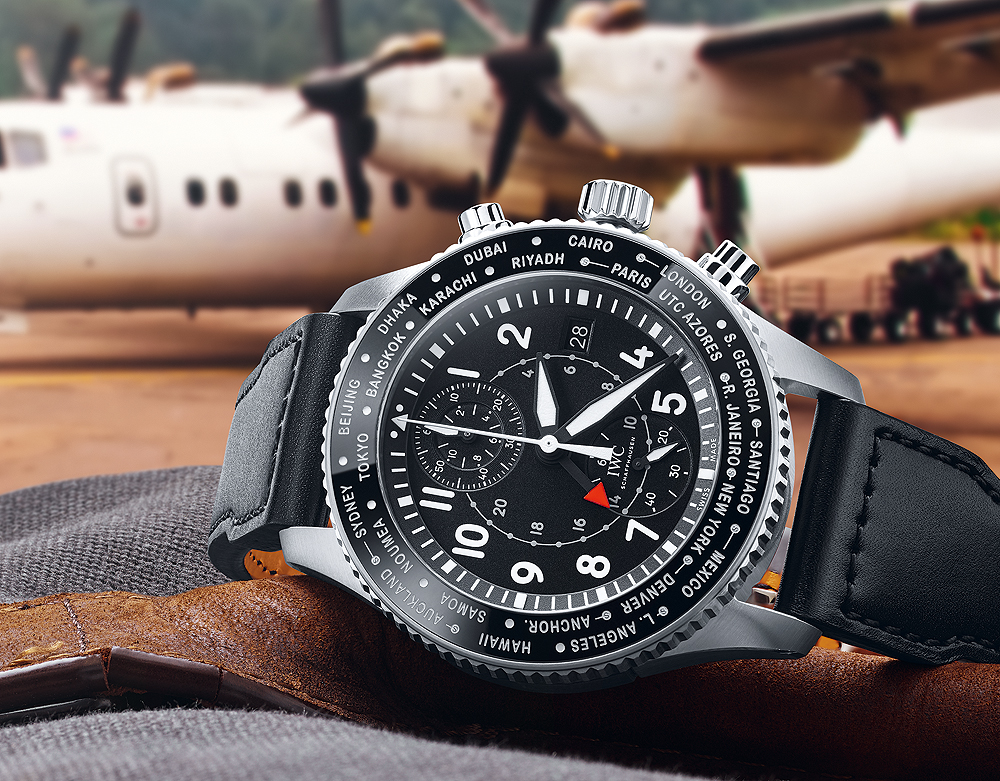
Flying through time zones with the IWC Pilot’s Watch Timezoner Chronograph is a reliable undertaking, not only because IWC’s expertise with pilots’ watches dates back to 1936. Once the time change has been programmed, it always works perfectly.
The programming sequence relies on an unusual arrangement between the case and the movement. To correctly set this world-time watch, you begin by pressing the rotatable bezel downward against the stainless-steel case, which is nearly 46 mm in diameter. Then you turn the depressed bezel until the reference location for your home time zone appears at 12 o’clock, directly above the little triangle on the flange. If daylight savings time is currently in effect, you must rotate the bezel one position farther until the city’s accompanying dot with the letter “S” (as in “summer”) is in the 12 o’clock position. When positioning the bezel, you must press the rotating ring down firmly at two opposite points and make sure that it clicks securely into the desired setting. This isn’t hard because the ring snaps into place with a click that you can both hear and feel. The click indicates that the adjusting process is complete. Now the rotatable ring can’t be repositioned by mistake.
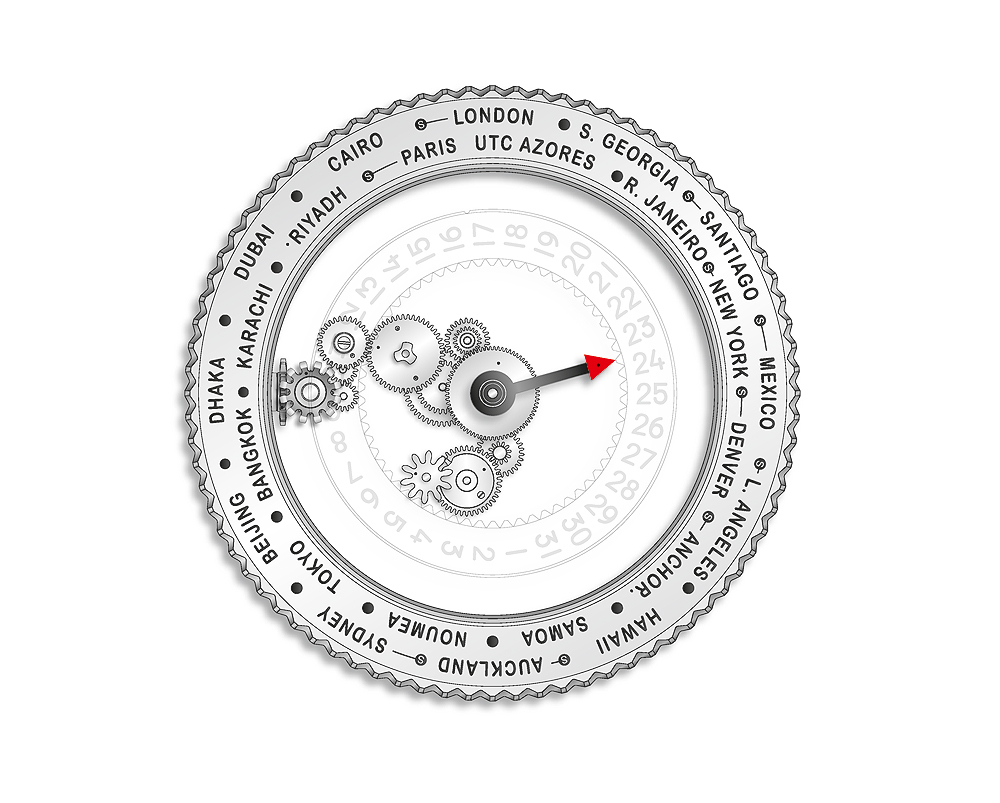
The Bezel Does What the Crown Used to Do
The next actor in the resetting drama is the crown, which must first be unlocked by turning it to the left. When you pull the crown out to its extracted position, the movement lets you reset the watch’s hands. What’s unusual is that the screw-down crown offers no middle position to quickly reset the date because this role is played by the rotatable bezel. This is an especially convenient feature at the end of a month with only 30 days. If you turn the bezel clockwise in hourly increments, the date switches each time the hour hand and an additional 24-hour hand pass through the midnight position. You now continue turning the bezel, which propels the hands so they point to the correct hour in your local time zone. The only detail to bear in mind here is that the 24-hour hand must also indicate the correct local time. Its red arrowhead shows the appropriate hour on the smaller 24-hour circle closer to the dial’s center.
And you’re done! From now on, all you do is turn the bezel whenever you want to reset your watch in hourly increments to show the time in a new zone. If you travel east, you turn the bezel clockwise. That’s logical, because the hour is later toward the east, where the sun has already been. If your journey takes you west, you turn the rotatable ring counterclockwise, because you are traveling “backward” in time, to an earlier hour. The date display always switches along with the hour hand, both forward and backward.
If you’re staying at an exotic location and want to know what time it is at home, or if you’re at home and you want to know what time it is elsewhere in the world, simply exert pressure evenly downward against the bezel and turn it until the desired location swings into the 12 o’clock position: a fascinating pastime.
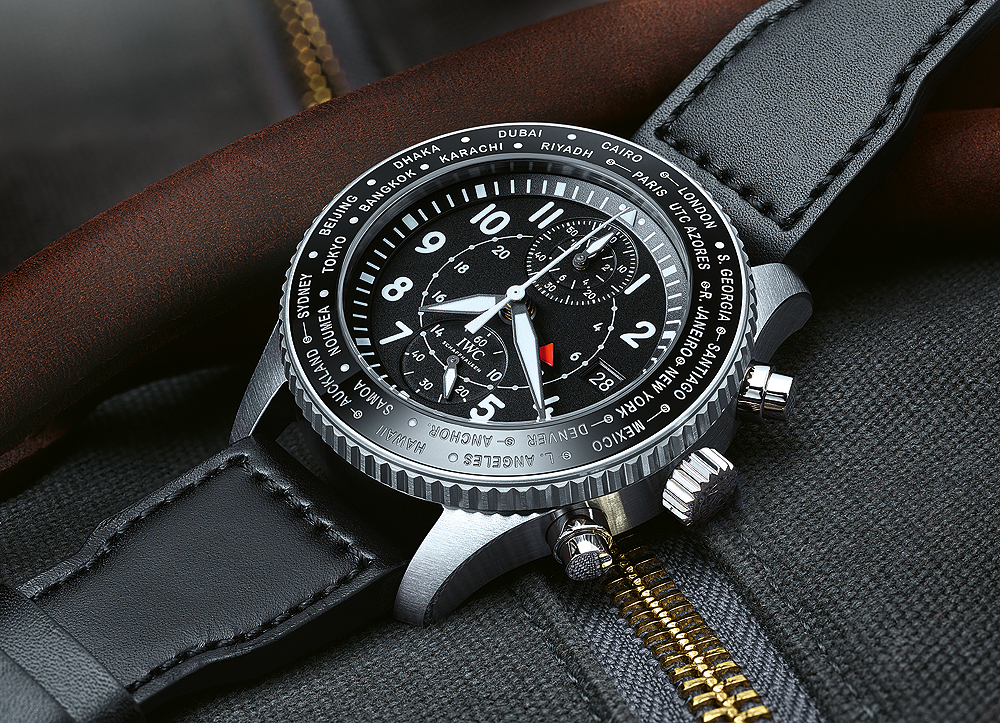
In 2014, IWC acquired the patents for this convenience from Vogard, a company that was founded in 2002, thus giving IWC an innovation that had been launched 10 years earlier. This type of world-time complication had never been seen in a wristwatch until that time. The owner of a Vogard watch could set it to show the world’s time zones simply by turning the bezel, which advanced the corresponding hand in hourly increments. Commenting on the sale of his company, Vogard owner Michael Vogt explained that as a watch studio and niche supplier, he did not have the financial and structural means to develop this innovative technology to its fullest potential.
Technology Transfer for Timezoner Mechanisms
IWC has developed Vogt’s innovation further. For example, the edge of the watch’s case no longer hosts a gigantic lever, which must be opened before the Timezoner function can be activated. Instead, the function is almost wholly concealed behind the left side of the case, where close scrutiny shows two narrow grooves toward the lugs.
IWC’s engineers combined three technologies for the Timezoner mechanism. First, there’s the city ring from the Pilot’s Watch Worldtimer: each city’s name represents one of the international time zones. Second, there’s the spring-loaded rotating bezel: first used on Porsche Design’s Ocean 2000 in the 1980s, this ring can only be rotated if pressure is applied simultaneously to two opposite points. Third, there’s the Aquatimer’s system of outer and inner rotating rings: this system transmits the movement of the outer bezel via a differential gear train to the hour wheel, the 24-hour hand and the date wheel. In addition, IWC combines the Timezoner function and its manufacture chronograph Caliber 89760. This combination doesn’t rely on a classic modular solution because the engagement with the movement comes from the bezel.
Integration into a chronograph mechanism already existed at Vogard in 2008, followed three years later by the patented date display and date switching. This is no longer connected to the originally set time but is synchronized with the displayed time zone. It conveniently switches forward or backward whenever the hour hand and 24-hour hand pass midnight. Independent watchmaker Andreas Strehler was involved with both developments. The original design was devised and constructed in collaboration with watchmaker Thomas Prescher.
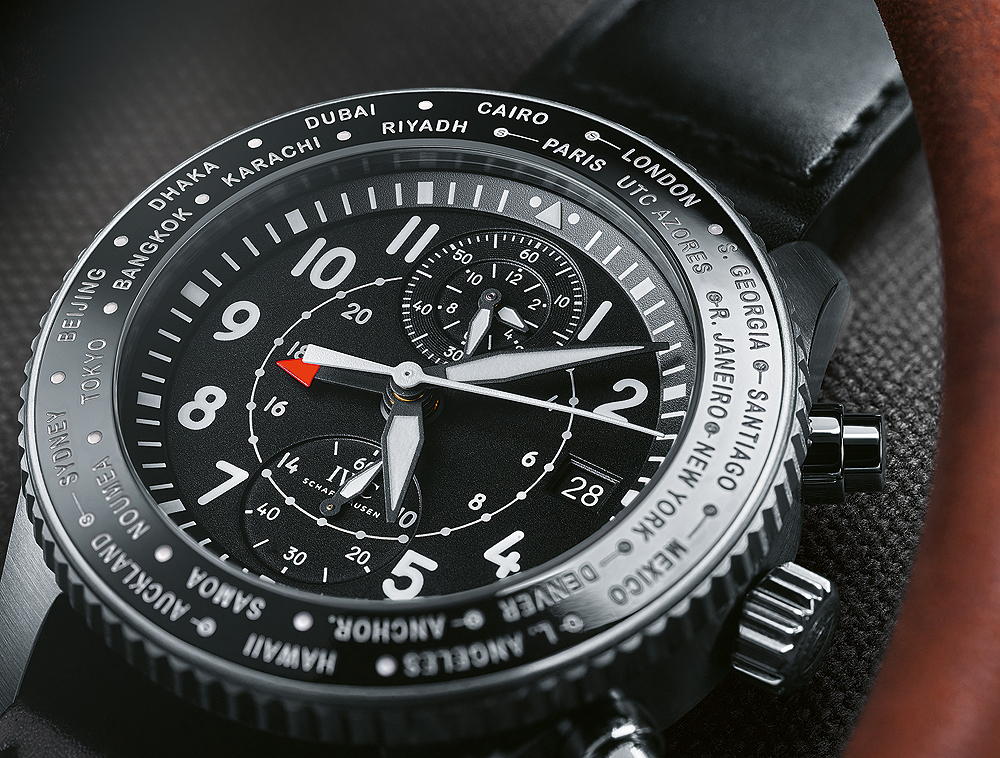
This system is amazingly simple compared to other world-time watches. The locking motion of the bezel is transmitted via the movement to the hour wheel and hour hands, as well as to the 24-hour hand and the date wheel, so all three displays can be reset forward or backward. A differential gear train powers both the single-hour jumps during time zone resetting and the continuous progress of the hour hand. The movement, with its continually advancing minutes hand and seconds hand, as well as the chronograph, all remain unaffected during resetting, so the watch still shows the correct time even after lengthy experimentation with the world-time display or, as in our test, indulging in a bit of playful toying.
Regarding timekeeping, IWC’s self-winding manufacture Caliber 89760 runs with reliably well-balanced rate performance inside this world-time watch. The construction lets you keep the chronograph in continuous operation, while the watch’s rate remains stable with an average gain of 2.9 seconds per day. A noteworthy and convenient feature is that the elapsed minutes and hours share a common subdial at 12 o’clock, where the elapsed time can be read intuitively, as on an ordinary dial.
A Rare Combination
Since the chronograph can be allowed to run uninterrupted, with a bit of planning you can use this display to show a second time. Furthermore, the chronograph is equipped with a flyback function that lets you start a new elapsed-time measurement directly from an ongoing one.
The movement boasts IWC’s characteristic features: sturdy construction, ratchet winding and a long power reserve of 68 hours. It’s a member of the 89000 caliber family, which was launched in 2007 with the 89360, the first chronograph movement developed entirely in Schaffhausen. The 89365 version also includes a flyback function. Further development to Caliber 89800 integrates a large digital display for the date and the month. Additional complications are found in Caliber 89630 (with perpetual calendar) and Caliber 89900 (with tourbillon). On the other hand, the 89760 movement that’s in our test watch is a practical version that’s well-suited for everyday use. The combination of world time and a chronograph is rarely found on the market. This rarity means that the IWC Pilot’s Watch Timezoner Chronograph is relatively appealing at a price of $11,900, although not a bargain.
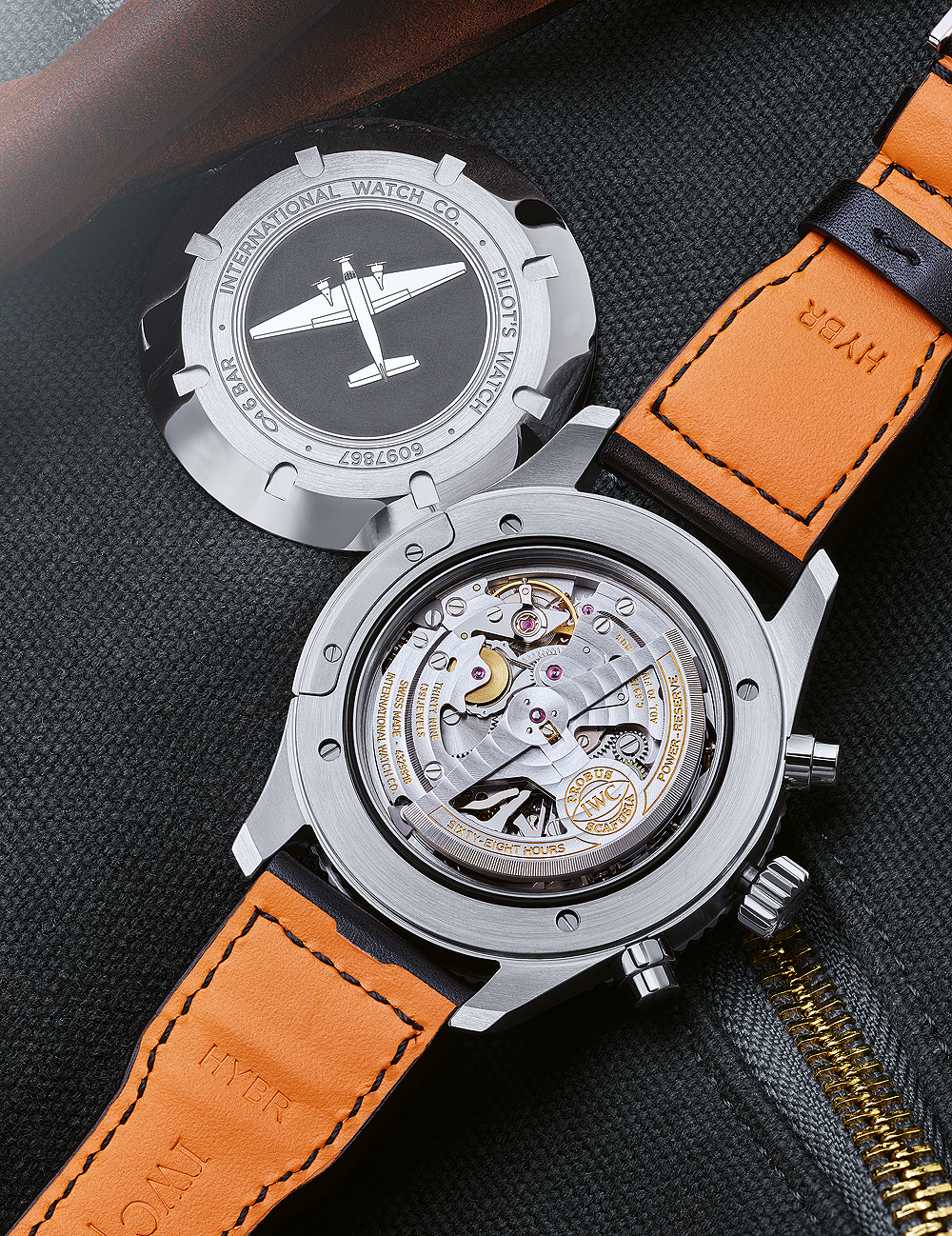
The typical styling of an IWC Pilot’s Watch unfolds beneath a sapphire crystal that has anti-reflective coating on both sides and is secured against a sudden loss of pressure. The pilots’-watch design features clearly legible numerals and hands, readability of the time at night, and bold contrast between black and white elements. This color scheme is matched by the date display. Relying on white numerals atop a black disk, this indicator gradually changes to show the next date each night at midnight. A clearly calibrated scale on the steep flange along the dial’s periphery does double duty for the minutes and the elapsed seconds. The 24-hour display is less visible on an anthracite-colored ring inside the hour circle.
With this distinctive outfit, the IWC Pilot’s Watch Timezoner Chronograph clearly succeeds as a classical pilots’ watch. The decisive elements of a pilots’ watch are kept in the foreground, while the additional functions and their corresponding scales convey an instrumental impression and a touch of aviator-style elegance.
SPECS:
Manufacturer: IWC Schaffausen, Baumgartenstrasse 15, 8200 Schaffausen, Switzerland
Reference number: IW395001
Functions: Hours, minutes, small seconds, date, chronograph (central elapsed-seconds hand, elapsed minutes and hours on a shared counter), fly-back, world-timer function via rotatable bezel and 24-hour display
Movement: IWC Caliber 89760 based on 89000, automatic, 28,800 vph, 39 jewels, Glucydur balance, Nivarox hairspring, four screws on the balance for fine adjustment, Incabloc shock absorption, 68-hour power reserve, diameter = 30.0 mm, height = 8.40 mm
Case: Stainless steel, curved sapphire crystal anti-reflectively treated on both sides above the dial, resistant to sudden loss of pressure, solid caseback, water resistant to 60 meters
Strap and clasp: Calfskin strap by Santoni, one-sided folding clasp
Rate results (deviation in seconds per 24 hours, fully wound/after 24 hours):
On the wrist +1.6
Dial up +4.1/+3.4
Dial down +4.7/+3.8
Crown up +0.6 -0.1
Crown down +1.4/+1.4
Crown left +2.0/+0.8
Greatest deviation 4.1/3.9
Average deviation +2.6/+1.9
Average amplitude:
Flat positions 308°/296°
Hanging positions 278°/261°
Dimensions: Diameter = 45.83 mm, height = 17.03 mm, weight = 162.5 g
Price: $11,900





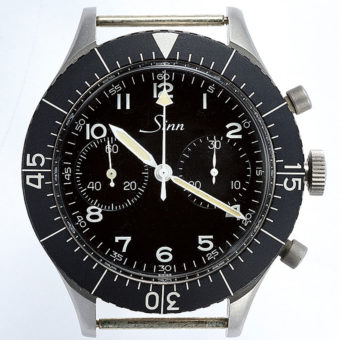

the markings of that bezel is inconsequential and impossible to interpret. actually you get the impression the designer is making a joke?
IWC, most over priced of the over priced Swiss watch trade.
That “reasonable” price is highly subjective.
Mike Vogt a great guy and very creative, I remember when he first joined TAG-Heuer, he came to the U.S. For a week and we ran around Southern California together giving him the lay of the land, Market, Players etc.. Over the years are paths crossed in Basel as we made various stops along the way. Like George Kern, the TAG-Heuer of the late 1980’s and ’90’s under Christian Viros, Luc Perramond and Philippe Champion spawned much talent in it’s re-birth.
Too large and to busy. If I’m flying at 300 or miles for hour or more I don’t have to mess with all those tiny figures on the watch face, I need to pay attention to what I’m doing. Besides, if I’m landing in Paris all I need to do is set my watch after landing.
Want to buy this watch. Already have a Portuguese Perpetual Calendar.
A beautiful watch but too big for my 16.5 wrist. When IWC will return to a smaller watch size as they do years before?